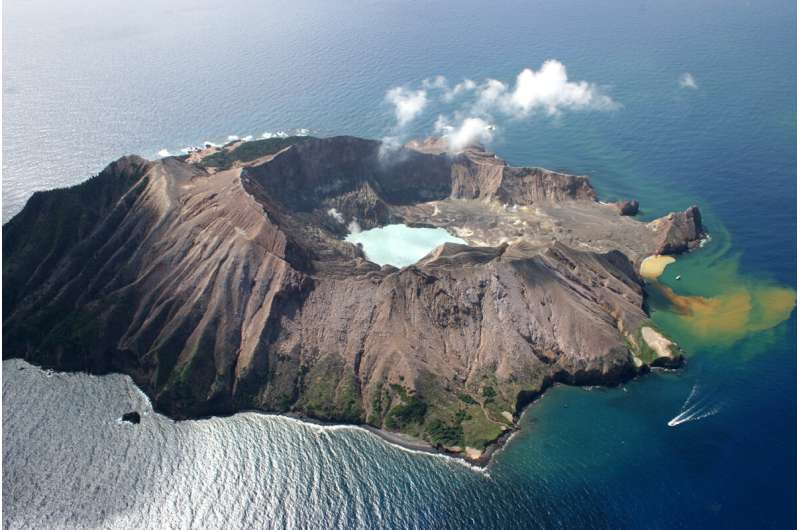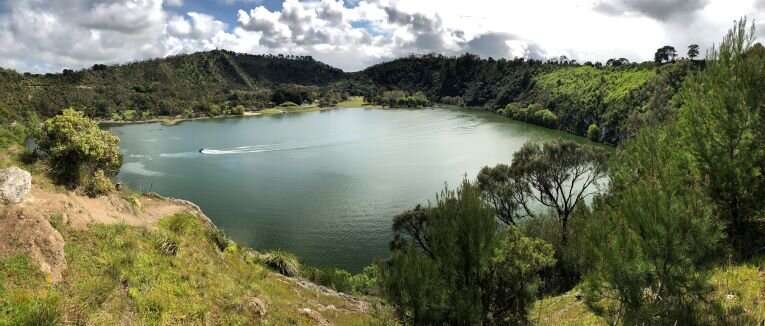Survey reveals low awareness of volcanic hazards in Australia

Heather Handley pointed out two large photos on her poster at AGU Fall Meeting last week: a bouncing kangaroo and a dreamy beach scene, two things commonly associated with Australia, where Handley is an associate professor in volcanology at Macquarie University. But Handley wasn't advertising Australia's most loved assets. The photos were a lead up to an introduction of one of her country's lesser known features: volcanoes.
On December 9, several Australians were among the dozens of tourists who were killed, injured, or went missing after a deadly eruption on Whakaari/White Island in New Zealand. Whakaari/White Island has seen more volcanic activity in the past 10 years than neighboring Australia has seen for 5,000, but according to volcanologists like Handley, the country is not free from the risks of a potential eruption. And according to a new survey conducted by Handley and her colleagues, Australian citizens are mostly unaware of their country's potential volcanic hazards.
Handley and colleagues came up with a series of questions for a survey, sent out just last month through social media and flyers, to find out just how much Australians understand the volcanic hazards and risk in their homeland.
At Fall Meeting, Handley presented the preliminary results from survey responses of over 100 Australians. She found that over 90 percent of respondents are unaware of any preparedness, emergency management plans, or warning systems in Australia for volcanic hazards.
Over 25 percent of survey takers said they weren't sure when the last volcanic eruption in mainland Australia occurred (Mt. Gambier, around 5,000 years ago). Additionally, for the statement "I am well aware of the procedures I need to follow in the event of an emergency related to a volcanic eruption," over 70 percent disagreed, and 60 percent strongly disagreed.
The survey participants did, however, seem to know that Australia could be impacted by volcanic activity in other countries, with nearly 80 percent agreeing with the statement.
A 2011 eruption in Chile may be partially responsible for this awareness, Handley said. Volcanic ash produced by that eruption entered Australian airspace, grounding planes and affecting over 100,000 passengers. Australia is also surrounded by several volcanically active countries: New Zealand, Indonesia, Papua New Guinea, and Tonga.

A more surprising result for Handley came from the question regarding various levels of concern for natural hazards in their country. For volcanic hazards, about 65 percent of people answered "not at all concerned" and zero people responded "extremely concerned."
In the same way the Chile eruption could have contributed to recent understanding of how volcanoes in other countries could impact Australia, Handley attributes the lack of concern for local volcanoes to timescales: the last eruption on the mainland occurred before Europeans colonized Australia.
But indigenous populations occupied Australia for around 65,000 years before European colonizers arrived, and they were aware of the volcanic hazards. "They did witness eruptions, and they did pass on that knowledge through oral traditions," Handley said. She's also looking at combining scientific data with indigenous knowledge to better improve scientists' understanding of volcanic activity in Australia.
Handley is just at the start of her surveying and anticipates a shift in future survey responses after the recent eruption on Whakaari/White Island. "It's probably triggering a few people to think about Australia—what is the risk to us from an eruption that might not be easy to predict," she said.
Handley studies the Newer Volcanics Province, a 400-kilometer swath of land stretching from Melbourne to South Australia, home to more than 400 small, previously active volcanoes. Predicting another eruption across such a wide area is tricky, because an eruption could happen anywhere, she said. Handley suspects the Newer Volcanics Province could see another eruption, based on chemical and geophysical signals pointing to magma in Earth's mantle beneath the Province.
Handley is also studying how quickly magma travels, which may help predict warning times if volcanic activity starts to increase. But prediction won't matter much if the public isn't aware of the risk, or if there is no plan in place in the case of an event in the Newer Volcanics Province, she said.
Handley hopes her research will help emergency management officials create tools and literature related to volcanic hazards preparedness.
Provided by American Geophysical Union
This story is republished courtesy of AGU Blogs (http://blogs.agu.org), a community of Earth and space science blogs, hosted by the American Geophysical Union. Read the original story here.



















